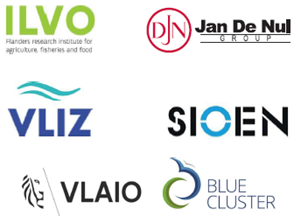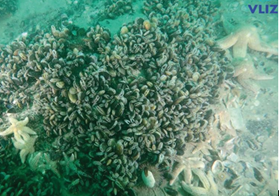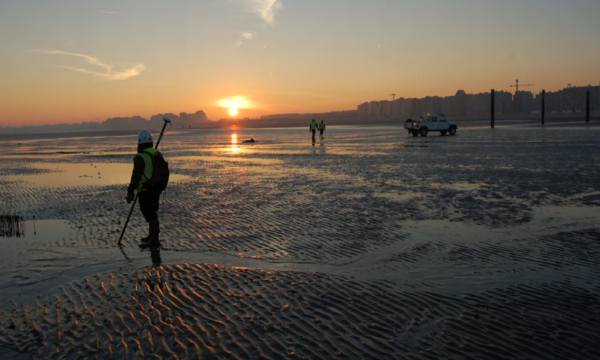Press release Biogenic mussel reef has potential as coastal protection technique and ecosystem enhancer
Promising results from Blue Cluster project Coastbusters 2.0
Intelligently engineered, self-growing mussel reefs at the boundary of shallow water (the foreshore) can reduce coastal erosion while making a positive contribution to biodiversity and the coastal ecosystem. This is evident from the Coastbusters research project.
After 6 years of experimentation and scientific observation at sea, a new nature-based coastal protection technique is on the table. One of the innovative elements in it is the so-called 'mussel shaker'. The new technique uses mussels to build a reef that acts as a biologically-reinforced dune-by-dike underwater, as the first hurdle against storm surge. Beach and dunes then become the second line of defense.
The biggest challenge was to find how best to help biobuilders such as mussels and sand mason worms settle under the prevailing conditions.

'There are now enough answers to speak of a promising concept. There is a blueprint for global application, sufficiently market-ready to start working with it in practice,' say the Coastbusters partners.
On October 16, 2023, the project results were presented to the press in Ostend, B, and to policymakers, marine stakeholders and NGOs during an afternoon symposium. Coastbusters is a Blue Cluster project with the partners DEME, JDN, Sioen, ILVO and VLIZ financially supported by VLAIO.
Climate change and sand loss: serious challenges
Rising sea levels and possibly more frequent future storms complicate the maintenance of the basic coastline in many countries. Governments must continually invest in dike reinforcements and elevations and massive sand replenishment. Conventional ways of coastal defense are in danger of becoming unaffordable. In many places, nature-based, sand-saving techniques for coastal protection are being developed and applied: dune planting, artificial sandbanks of all kinds.
With their combined technical, biological, ecological and socioeconomic expertise, Coastbusters partners targeted an innovative method starting in 2017: A biogenic reef in the foreshore, made from local bio-builders, as a working underwater shore-by-dune or shore-by-beach.
Tomas Sterckx, Coastbusters project coordinator (DEME): 'The collaboration with biologists is particularly enriching and has yielded new techniques for coastal protection. These techniques complement traditional methods, such as sand replenishment or dike reinforcement. We now consider coastal zone management as a comprehensive approach to the entire coastal strip. Underwater biological protection lines are proving to be a promising technique.'
De Coastbusters technique
The innovation is the combination of aquaculture techniques (hanging cultures) with ingenious mussel shakers. In essence, the search aimed to develop the reef adapted to local conditions: which species? what properties for the ropes used? which set-up?
In a spacious test setup about 2 kilometers off the coast of De Panne, different species and techniques were first tested separately as biogenic builders. Mussels and sand mason worms proved to be better reef-building pioneer species than oysters and seaweed.
Ine Moulaert, Blue Innovation Officer at VLIZ: “Our innovative monitoring techniques including the VLIZ underwater drones made it possible to closely follow the evolution of the mussel reef, even during storm conditions.”
The most optimal formula proposed thus far is an elongated mussel reef installed parallel to the shoreline, which expands in a balanced and continuous manner, including other species such as sand mason worms and seaweeds. The natural growth of the reef should come into balance with the growth inhibiting action of predators (starfish and crabs) and high physical environmental stress (wave action).
Sustainability and ecosystem services built in and monitored
Since the North Sea is among one of the roughest seas, it can never be ruled out that materials may be damaged and enter the marine ecosystem. Within the Coastbusters project, Sioen succeeded in identifying bioplastics that slowly biodegrade under marine conditions.
Bert Groenendaal, R&D coordinator at Sioen: ‘Sioen is a global player in technical textiles and is concerned with the problem of microplastics. The developed bioplastics have been processed into fibers and ropes suspended as droppers in the North Sea for the capture of baby mussels. They will degrade within a certain period of time under the influence of microorganisms.’
The reef itself already brings two possible environmental benefits, ILVO biomonitoring shows.
Alexia Semerano, marine researcher at ILVO: ‘'The research sites attract a lot of additional marine life and thus successfully promote biodiversity. Second, mussels are filter animals that get their nutrients from the water. So the net effect is (slightly) cleaner seawater.'

A hypothesis to be further substantiated is the beneficial climate effect. Mussels also absorb CO2 and store it for a long time in their shell under the form of calcium carbonate. This is a (small) form of blue carbon storage.
Value creation, locally and even globally
The two participating aquatic engineering firms already see a future in working with nature-based coastal protection technology. Mussels can be found almost everywhere in the world, making a technique they deploy as a reef builder in principle widely implementable. Provided a preliminary study of the local soil and flow conditions.
Jan Fordeyn, R&D firm Jan Denul: ‘Coastbusters technology has reached a pivotal point: the proof of concept is in place. With further optimized engineering, efficient installation procedures and adapted monitoring, we can start thinking about practical applications. With our experience and specialized fleet, our ambition is to bring this to market.’
For the fishing industry, a strip of coastal protection reefs would not be appropriate for trawling. A combination with passive fishing of the latest generation could be explored. ILVO has already studied the feasibility of hanging culture (mussels and oysters) with pot fishing (cuttlefish and lobsters). The question is whether pot fishing near a coastal reef can be efficiently combined with the necessary management and monitoring tasks above the reef.
Jo Brouns, Flemish Minister of Economy, Work, Innovation and Agriculture: ‘Coastbusters is a wonderful example of Flemish innovation and a showpiece of the Blue Cluster. The effect on the Flemish economy of the € 2 million research funding from Flanders, combined with € 1 million co-financing from three private players, is gradually becoming visible. A 'coastal' market is developing with these new forms of coastal protection. Flemish knowledge and expertise will soon translate into successful national and international applications.‘
Minister of the North Sea Vincent Van Quickenborne: ‘This summer we reached a milestone in North Sea mariculture with the first Belgian mussels. The Coastbusters project now shows that mussels have additional assets, as a natural, protective buffer. We need smart solutions like this. Once again, it makes our North Sea a model of innovative and future-oriented research.’


